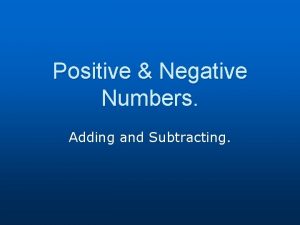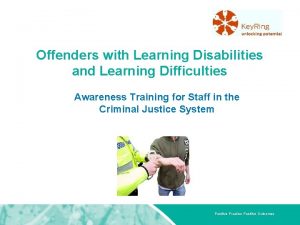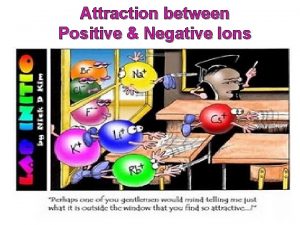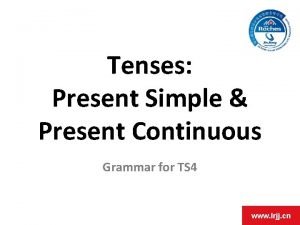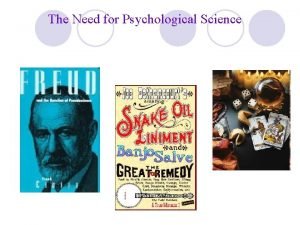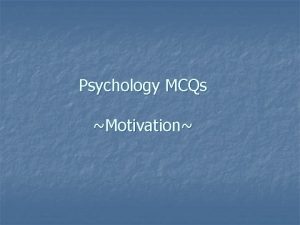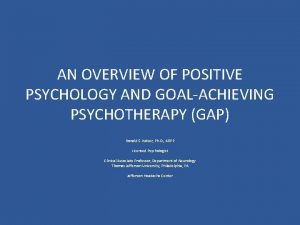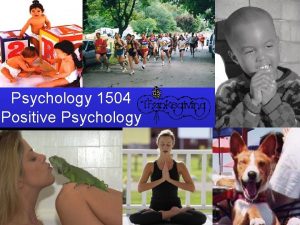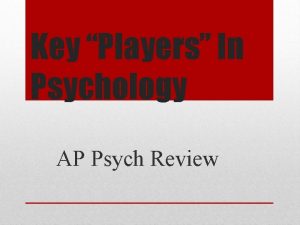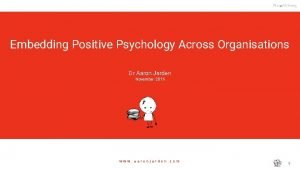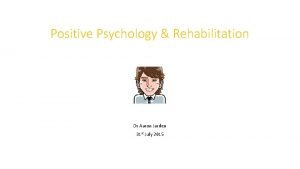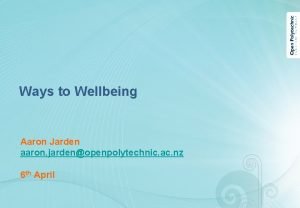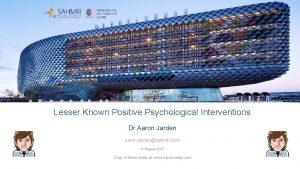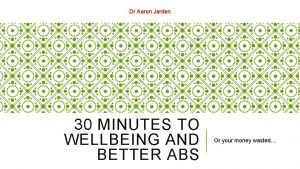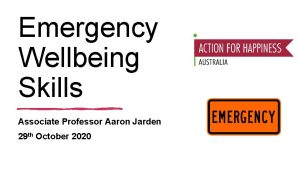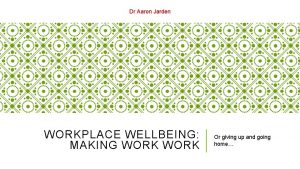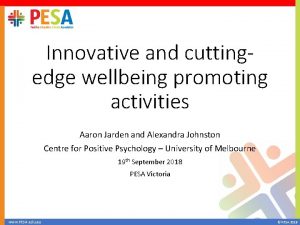Dr Aaron Jarden POSITIVE PSYCHOLOGY Or other interesting















- Slides: 15

Dr Aaron Jarden POSITIVE PSYCHOLOGY Or other interesting things…

NEW ZEALAND ASSOCIATION OF POSITIVE PSYCHOLOGY http: //www. positivepsychology. org. nz/

POSITIVE INTRODUCTIONS o Step 1: Pair up. o Step 2: In 2 minutes (1 minute each), tell a story – a thoughtful narrative with a beginning, middle and end – that illustrates when you are at your best. o Note: Swap when you hear the bell the first time after 1 minute, and then stop completely when you hear the bell the second time after 2 minutes. Key point: Wield your strengths – they are paths to engagement and enjoyment.

WHAT IS POSITIVE PSYCHOLOGY? "There are two complementary strategies for improving the human condition. One is to relieve what is negative in life; the other is to strengthen what is positive. Mainstream psychology focuses largely on the first strategy; Positive Psychology emphasizes the second" - Martin Seligman "Positive psychology is the scientific study of what enables individuals and communities to thrive" - International Positive Psychology Association.

WHAT IS POSITIVE PSYCHOLOGY? o 4 min video animation

WHAT IS POSITIVE PSYCHOLOGY? o Previous focus on pathology; disease model (what’s going wrong) – World Wars and trauma, and yet some great progress in treatment! o PP aims to improve quality of life (what’s going right) – for individuals and various groups to flourish… o A science of positive psychology – it’s not self help, or life coaching… Humanistic psychology did not have much of an empirical base…. PP is providing an empirically sound vision of the good life (what makes life worth living)… o Positive psychology interventions (PPI’s) work – roughly about d =. 3 effect size (increasing good & reducing bad): o. Sin, N. L. , & Lyubomirsky, S. (2009). Enhancing well-being and alleviating depressive symptoms with positive psychology interventions: a practice-friendly meta-analysis [Meta-Analysis]. Journal of clinical psychology, 65(5), 467 -487. doi: 10. 1002/jclp. 20593 o. Bolier, L. , Haverman, M. , Westerhof, G. J. , Riper, H. , Smit, F. , & Bohlmeijer, E. T. (2013). Positive psychology interventions: a meta-analysis of randomized controlled studies. BMC Public Health, 13(1), 119.

WHAT IS POSITIVE PSYCHOLOGY? o PPI’s aim: o Fordyce pioneering work showed it was possible to significantly boost happiness levels among non-clinical populations using a package of interventions (Fordyce, 1977, 1983) o Past 15 years has seen rapid growth in interest and research in positive mental health. o Considerable positive outcomes associated with happiness (for a review see Lyubomirsky, King, & Diener, 2005). o Positive psychology’s academic output is growing proportionately faster than psychological research as a whole (Rusk & Waters, 2013). o Positive psychology related documents account for between 10% and 36% of research in the fields of counselling, education, organisational science, behavioural medicine, and health psychology (Rusk & Waters, 2013).

WHAT IS POSITIVE PSYCHOLOGY? o Positive Education o Positive Health o Positive Assessment o Positive Psychotherapy o Positive Organisations

FIVE WAYS TO WELLBEING v. Step 1: Pair up with a different partner, get a pen ready, as well as a blank A 4 page… v. Step 2: Raise a hand in the air when you're ready… v. Step 3: Without looking down at your blank page, and ONLY looking at your partner’s face, you have 1 minute to draw a portrait of your partner, starting on the bell! v. Step 4: Sign your name, date it, and swap pictures with your partner…

FIVE WAYS: CONNECT, BE ACTIVE, TAKE NOTICE, KEEP LEARNING, GIVE Connect – Make connections with friends, family, colleagues and neighbours. When you build these connections they help enrich your life with new experiences and opportunities. Be Active – Get moving. Walk, skip, run, dance – move your muscles. Exercise not only makes you feel good, it keeps you healthy. Pick a physical activity that you enjoy. Take Notice – Be mindful. Be curious. Like a child, see the wonder and beauty of the world. Notice things around you – the weather, the landscape, the mood and feelings of the people around you. In noticing you learn to appreciate things that matter. Keep Learning – We never stop learning. Keep trying something new – a new course you’ve been wanting to do or a more challenging task at work. Challenges keep us on our toes and increase our confidence and excitement in our day. Give – Be generous with your time, your knowledge and your talents, giving to friends, family and even strangers. Be thankful, smile at people, and volunteer. Sharing to a wider audience gives you a greater reward than just doing things for yourself.

SAVOUR YOUR EXPERIENCES v. Savouring involves being “in the moment” and “taking in” all that an experience has to offer. Think of it as wringing the pleasure juice out of life by giving attention to the pleasures of the moment. v. Savouring can be used in a wide variety of circumstances – one can savour a sensory experience, a social experience, a feeling, or even a memory. v. There are ten different types of savouring strategies - sharing with others, memory building, self-congratulation, sensory-perceptual sharpening, comparing, absorption, behavioural expression, temporal awareness, counting blessings, and kill-joy thinking. v. We are going to try a combo of “sensory-perceptual sharpening” and “absorption”.

SAVOUR YOUR EXPERIENCES v Step 1: get another almond. v Step 2: Take a close look at it – inspect it, examine it! What does it look like? Is it symmetrical? v Step 3: Close your eyes for the rest of this experience and feel it in your hand – what does the texture feel like? v Step 4: Smell it. What does it smell like? v Step 5: Put the almond into your mouth but do not bite or suck it – just let it rest on your tongue. Explore the almond with your tongue and teeth, noticing as much as you can. v Step 6: Bite slowly into it and focus on the taste. Swirl the contents of the almond around in your mouth. v Step 7: Swallow the almond and open your eyes. Was it easy to stay focused as you tapped your senses and became absorbed in the sensory experience? What was it like to pay attention to each individual detail of the experience? Was this almond more enjoyable than the previous almond?

PEAK-END THEORY v. Peak-end theory states that people’s judgments of their overall experience (like of this 30 minute talk) is greatly influenced by the peak of their experience, and how it ends. v. The research indicates that we judge our past experiences almost entirely on how they were at their peak and how they ended… v. It has to do with our memory of experiences

A WELLBEING OVERVIEW v. Invest time and effort in family connections v. We are social creatures so be enmeshed in a community of friends - deep and meaningful relationships v. Savour the now regularly – rather than the past or future v. Slow down – perhaps meditate? v. Be curious v. Know your personal values and live by them. Similarly, know your purpose and what derives meaning for you v. Look after your health (the below 5 can make approximately 14 years difference to your life v. Know you personal strengths and find ways to exercise expectancy - the quality of both your current life and them every day those extra 14 years) v Eat real food – not too much, and mostly plants v. Develop and optimistic thinking style v Exercise regularly – and different types: aerobic, resistance, flexibility, balance v. Invest your money in experiences rather than things v Drink alcohol in moderation v. Be in work, and work that you enjoy v Don’t smoke v. Be grateful v Get enough quality sleep Caveat: Genetics and upbringing also make a slight bit of difference, but since you can’t do too much about those, don’t worry about them…

Dr Aaron Jarden aaron@jarden. co. nz www. aaronjarden. com
 Interesting more interesting the most interesting
Interesting more interesting the most interesting Dr jarden
Dr jarden Positive psychology ap psychology definition
Positive psychology ap psychology definition Staphylococcus epidermidis en agar sangre
Staphylococcus epidermidis en agar sangre Adding and subtracting negative numbers rules
Adding and subtracting negative numbers rules Positive practice positive outcomes
Positive practice positive outcomes Electrostatic attraction between positive and negative ions
Electrostatic attraction between positive and negative ions Andy sometimes read comics
Andy sometimes read comics Self-initiated other-repair
Self-initiated other-repair Examples of naturalistic observation
Examples of naturalistic observation Positive psychology mcqs
Positive psychology mcqs Computer metaphor
Computer metaphor Concepts of positive psychology
Concepts of positive psychology Positive psychology 1504
Positive psychology 1504 Strath haven positive psychology curriculum
Strath haven positive psychology curriculum Positive psychology ap psych
Positive psychology ap psych




